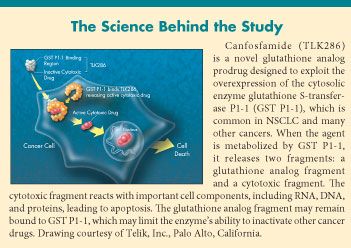Canfosfamide Boosts Chemotherapy's Benefit in NSCLC
A triplet that includes the investigational agent canfosfamide (Telcyta, Telik, Inc.) showed strong activity as first-line treatment in patients with advanced non-small-cell lung cancer (NSCLC)
LOS ANGELESA triplet that includes the investigational agent canfosfamide (Telcyta, Telik, Inc.) showed strong activity as first-line treatment in patients with advanced non-small-cell lung cancer (NSCLC). Furthermore, maintenance therapy with canfosfamide alone improved progression-free and overall survival. Lecia V. Sequist, MD, MPH, of the Massachusetts General Hospital (MGH) Cancer Center, Center for Thoracic Cancers, reported the findings at the 2007 American Association for Cancer Research annual meeting (abstract 3521).
With the combination regimen, the overall response rate was 34%, stable disease 43%, median progression-free survival 4.9 months, and median overall survival 9.6 months. With the lowest dose (400 mg/m2), the response rate was 67% and median survival was 14.5 months, but there were only three patients at this dose level.
"We saw activity comparable to what we now see with bevacizumab [Avastin] added," said Dr. Sequist, noting that the study was performed before bevacizumab became established as part of the NSCLC regimen. She added that this triplet might be valuable in patients who cannot receive bevacizumab.
The current clinical trial was a multicenter phase II dose-ranging study of the combination of canfosfamide (400, 500, 750, or 1,000 mg/m
2
), carboplatin (AUC 6), and paclitaxel (200 mg/m
2
), all given as infusions on day 1 every 3 weeks, in 129 patients with stage IIIB or IV NSCLC. Most patients (95%) had received no prior treatment. Patients showing clinical benefit from the combination were allowed to continue maintenance treatment with canfosfamide alone every 3 weeks.
Study Results
Depending on the dose level of the canfosfamide, response rates ranged from 28% to 68%; stable disease rates from 0% to 48%; overall disease stabilization rates from 67% to 86%; median progression-free survival from 4.2 to 6.8 months; median survival from 7.7 to 14.5 months; 1-year survival from 35% to 43%; and 18-month survival from 19% to 29%.
Among the 100 patients (77%) who achieved a response or stable disease, 50 received canfosfamide maintenance consolidation therapy and 50 did not. Patients receiving maintenance treatment had a median progression-free survival of 6.9 months vs 4.2 months without, for a 64% reduction in risk of progression (P < .0001). Median overall survival was 14.2 months vs 8.4 months, respectively, for a 60% reduction in risk (P = .0003).

For the triplet regimen, the most common toxicities were hematologic, which were well managed with dose reductions or growth factor support. Maintenance therapy was also well tolerated. "Three patients at MGH have received over a year of canfosfamide at this point, which is typical for NSCLC patients," she noted.
Future phase III studies with this triplet in NSCLC and ovarian cancer are planned, although the dose level has not yet been established, she said.
Eric Ko on Combining Radiation Therapy With Immunotherapy to Treat Non–Small-Cell Lung Cancer
September 18th 2018ONCOLOGY spoke with Eric Ko, MD, PhD, who recently published a review article with his colleagues on strategies for combining radiation therapy with immunotherapy for the treatment of non–small-cell lung cancer.